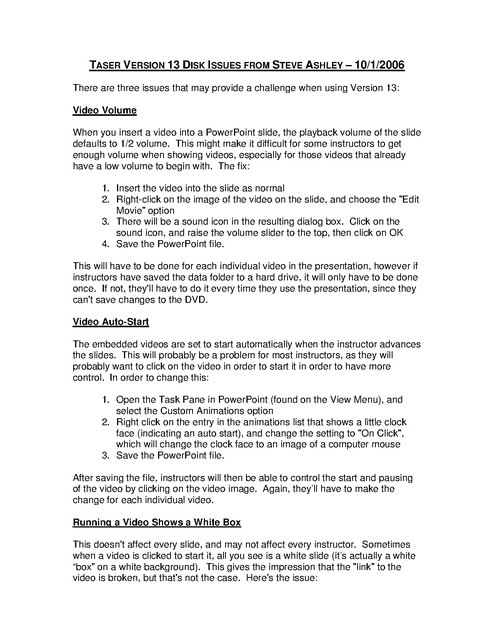Taser Version 13 Disk Issues Steve Ashley 2006
Download original document:

Document text

Document text
This text is machine-read, and may contain errors. Check the original document to verify accuracy.
TASER VERSION 13 DISK ISSUES FROM STEVE ASHLEY – 10/1/2006 There are three issues that may provide a challenge when using Version 13: Video Volume When you insert a video into a PowerPoint slide, the playback volume of the slide defaults to 1/2 volume. This might make it difficult for some instructors to get enough volume when showing videos, especially for those videos that already have a low volume to begin with. The fix: 1. Insert the video into the slide as normal 2. Right-click on the image of the video on the slide, and choose the "Edit Movie" option 3. There will be a sound icon in the resulting dialog box. Click on the sound icon, and raise the volume slider to the top, then click on OK 4. Save the PowerPoint file. This will have to be done for each individual video in the presentation, however if instructors have saved the data folder to a hard drive, it will only have to be done once. If not, they'll have to do it every time they use the presentation, since they can't save changes to the DVD. Video Auto-Start The embedded videos are set to start automatically when the instructor advances the slides. This will probably be a problem for most instructors, as they will probably want to click on the video in order to start it in order to have more control. In order to change this: 1. Open the Task Pane in PowerPoint (found on the View Menu), and select the Custom Animations option 2. Right click on the entry in the animations list that shows a little clock face (indicating an auto start), and change the setting to "On Click", which will change the clock face to an image of a computer mouse 3. Save the PowerPoint file. After saving the file, instructors will then be able to control the start and pausing of the video by clicking on the video image. Again, they’ll have to make the change for each individual video. Running a Video Shows a White Box This doesn't affect every slide, and may not affect every instructor. Sometimes when a video is clicked to start it, all you see is a white slide (it’s actually a white “box” on a white background). This gives the impression that the "link" to the video is broken, but that's not the case. Here's the issue: A little known fact about PowerPoint is that there is a 128 character limit for any hyperlinked file. If a video or any other item linked to a slide has a file location (on the user’s hard drive) that is longer than 128 characters, this problem occurs. When the files are on the DVD, the file path is shorter than 128 characters, so all the videos play. However, when an instructor copies the data folder to their computer, the path will change, and may grow longer than the limit, depending on where they save the folder on their hard drive. This will not be a problem for everyone, and not for every file. However, an example of the problem occurs when the data directory is saved to the Windows "Desktop" (in a normal Windows XP installation, the path to the user’s Desktop is C://Windows/Documents and Settings/Your Name/File Name). There's no way to be sure which instructors and which files this will affect, so the instructions for correcting it need to be generic in nature. Each instructor should, after copying the data folder to their computer, run through the presentation in Slideshow mode, and check each video. If, when they click it to play it, a white box appears (or if they have the videos still set to start automatically when the slide advances, the slide may come up white and not show the video at all), they will need to do the following: 1. 2. 3. 4. 5. 6. 7. Go into PowerPoint “edit” mode, and navigate to the problem slide Right click on the video image, and select the Edit Movie Object option Note the video's file name Click on OK to close the Edit Movie Object dialog box Do this for each problem slide, then Close PowerPoint Go into My Computer and navigate to the data folder on your hard drive, then find the video file 8. Change (Rename) the file name to something shorter. Note your revised file name 9. After renaming each problem file, restart PowerPoint 10. Go back to the errant slide in PowerPoint edit mode and delete the embedded video from the slide 11. Go to the Insert Menu, and choose Movies and Sounds, then Movie from File. Navigate to the revised file name, and double click it to make the new insertion. 12. During the insertion, PowerPoint will ask whether you want to start the video automatically, or when it is clicked 13. You may have to resize the video image for optimal viewing. 14. Remember to reset the volume to its loudest setting, as described above 15. Save the PowerPoint file. -----------------------Some instructors may see slightly different commands than outlined above; these steps are for PowerPoint 2003.

